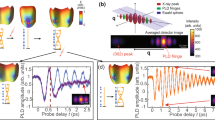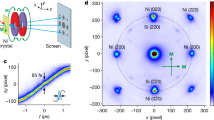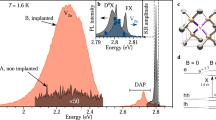Abstract
Longitudinal relaxation is the process by which an excited spin ensemble decays into its thermal equilibrium with the environment. In solid-state spin systems, relaxation into the phonon bath usually dominates over the coupling to the electromagnetic vacuum1,2,3,4,5,6,7,8,9. In the quantum limit, the spin lifetime is determined by phononic vacuum fluctuations10. However, this limit was not observed in previous studies due to thermal phonon contributions11,12,13 or phonon-bottleneck processes10, 14,15. Here we use a dispersive detection scheme16,17 based on cavity quantum electrodynamics18,19,20,21 to observe this quantum limit of spin relaxation of the negatively charged nitrogen vacancy (NV−) centre22 in diamond. Diamond possesses high thermal conductivity even at low temperatures23, which eliminates phonon-bottleneck processes. We observe exceptionally long longitudinal relaxation times T1 of up to 8 h. To understand the fundamental mechanism of spin–phonon coupling in this system we develop a theoretical model and calculate the relaxation time ab initio. The calculations confirm that the low phononic density of states at the NV− transition frequency enables the spin polarization to survive over macroscopic timescales.
This is a preview of subscription content, access via your institution
Access options
Access Nature and 54 other Nature Portfolio journals
Get Nature+, our best-value online-access subscription
$29.99 / 30 days
cancel any time
Subscribe to this journal
Receive 12 print issues and online access
$259.00 per year
only $21.58 per issue
Buy this article
- Purchase on Springer Link
- Instant access to full article PDF
Prices may be subject to local taxes which are calculated during checkout



Similar content being viewed by others
References
Waller, I. Über die Magnetisierung von paramagnetischen Kristallen in Wechselfeldern. Z. Phys. 79, 370–388 (1932).
Purcell, E. M. Spontaneous emission probabilities at radio frequencies. Phys. Rev. 69, 674–674 (1946).
Overhauser, A. W. Paramagnetic relaxation in metals. Phys. Rev. 89, 689–700 (1953).
Elliott, R. J. Theory of the effect of spin–orbit coupling on magnetic resonance in some semiconductors. Phys. Rev. 96, 266–279 (1954).
Orbach, R. Spin–lattice relaxation in rare-earth salts. Proc. R. Soc. A 264, 458–484 (1961).
Yafet, Y. g factors and spin–lattice relaxation of conduction electrons. Solid State Phys. 14, 1–98 (1963).
Culvahouse, J. W., Unruh, W. P. & Brice, D. K. Direct spin–lattice relaxation processes. Phys. Rev. 129, 2430–2440 (1963).
Wu, M., Jiang, J. & Weng, M. Spin dynamics in semiconductors. Phys. Rep. 493, 61–236 (2010).
Baral, A., Vollmar, S., Kaltenborn, S. & Schneider, H. C. Re-examination of the Elliott–Yafet spin-relaxation mechanism. New J. Phys. 18, 023012 (2016).
Scott, P. L. & Jeffries, C. D. Spin–lattice relaxation in some rare-earth salts at helium temperatures; observation of the phonon bottleneck. Phys. Rev. 127, 32–51 (1962).
Harrison, J., Sellars, M. J. & Manson, N. B. Measurement of the optically induced spin polarisation of N-V centres in diamond. Diam. Relat. Mater. 15, 586–588 (2006).
Jarmola, A., Acosta, V. M., Jensen, K., Chemerisov, S. & Budker, D. Temperature- and magnetic-field-dependent longitudinal spin relaxation in nitrogen-vacancy ensembles in diamond. Phys. Rev. Lett. 108, 197601 (2012).
Mrózek, M. et al. Longitudinal spin relaxation in nitrogen-vacancy ensembles in diamond. EPJ Quant. Technol. 2, 22 (2015).
Ruby, R. H., Benoit, H. & Jeffries, C. D. Paramagnetic resonance below 1K: Spin-lattice relaxation of Ce3+ and Nd3+ in lanthanum magnesium nitrate. Phys. Rev. 127, 51–56 (1962).
Tesi, L. et al. Giant spin–phonon bottleneck effects in evaporable vanadyl-based molecules with long spin coherence. Dalton. Trans. 45, 16635–16643 (2016).
Brune, M. et al. From Lamb shift to light shifts: vacuum and subphoton cavity fields measured by atomic phase sensitive detection. Phys. Rev. Lett. 72, 3339–3342 (1994).
Schuster, D. I. et al. Resolving photon number states in a superconducting circuit. Nature 445, 515–518 (2007).
Mabuchi, H. Cavity quantum electrodynamics: coherence in context. Science 298, 1372–1377 (2002).
Xiang, Z. Z.-L., Ashhab, S., You, J. J. & Nori, F. Hybrid quantum circuits: Superconducting circuits interacting with other quantum systems. Rev. Mod. Phys. 85, 623–653 (2013).
Kubo, Y. et al. Hybrid quantum circuit with a superconducting qubit coupled to a spin ensemble. Phys. Rev. Lett. 107, 220501 (2011).
Amsüss, R. et al. Cavity QED with magnetically coupled collective spin states. Phys. Rev. Lett. 107, 060502 (2011).
Jelezko, F. & Wrachtrup, J. Single defect centres in diamond: a review. Phys. Status Solidi A 203, 3207–3225 (2006).
Slack, G. A. Thermal conductivity of pure and impure silicon, silicon carbide, and diamond. J. Appl. Phys. 35, 3460–3466 (1964).
Feher, G. Electron spin resonance experiments on donors in silicon. I. Electronic structure of donors by the electron nuclear double resonance technique. Phys. Rev. 114, 1219–1244 (1959).
Tyryshkin, A. M. et al. Electron spin coherence exceeding seconds in high-purity silicon. Nat. Mater. 11, 143–147 (2011).
Ivády, V., Simon, T., Maze, J. R., Abrikosov, I. & Gali, A. Pressure and temperature dependence of the zero-field splitting in the ground state of NV centers in diamond: a first-principles study. Phys. Rev. B 90, 235205 (2014).
Doherty, M. W. et al. Temperature shifts of the resonances of the NV-center in diamond. Phys. Rev. B 90, 041201(R) (2014).
Tavis, M. & Cummings, F. Exact solution for an N-molecule radiation-field Hamiltonian. Phys. Rev. 170, 379–384 (1968).
Bienfait, A. et al. Controlling spin relaxation with a cavity. Nature 531, 74–77 (2015).
Dicke, R. Coherence in spontaneous radiation processes. Phys. Rev. 24, 99–110 (1954).
Angerer, A. et al. Collective strong coupling with homogeneous Rabi frequencies using a 3D lumped element microwave resonator. Appl. Phys. Lett. 109, 033508 (2016).
Nöbauer, T. et al. Creation of ensembles of nitrogen-vacancy centers in diamond by neutron and electron irradiation. Preprint at http://arXiv.org/abs/1309.0453 (2013).
Hanson, R., Kouwenhoven, L. P., Petta, J. R., Tarucha, S. & Vandersypen, L. M. K. Spins in few-electron quantum dots. Rev. Mod. Phys. 79, 1217–1265 (2007).
Wei, L., Kuo, P. K., Thomas, R. L., Anthony, T. R. & Banholzer, W. F. Thermal conductivity of isotopically modified single crystal diamond. Phys. Rev. Lett. 70, 3764–3767 (1993).
Balasubramanian, G. et al. Ultralong spin coherence time in isotopically engineered diamond. Nat. Mater. 8, 383–387 (2009).
Safavi-Naeini, A. H. et al. Two-dimensional phononic-photonic band gap optomechanical crystal cavity. Phys. Rev. Lett. 112, 153603 (2014).
O’Connell, A. D. et al. Quantum ground state and single-phonon control of a mechanical resonator. Nature 464, 697–703 (2010).
Sandner, K. et al. Strong magnetic coupling of an inhomogeneous nitrogen-vacancy ensemble to a cavity. Phys. Rev. A 85, 053806 (2012).
Mahan, G. Many-particle physics. in Physics of Solids and Liquids (Springer, Boston, MA, 2013).
Kresse, G. & Furthmüller, J. Efficient iterative schemes for ab initio total-energy calculations using a plane-wave basis set. Phys. Rev. B 54, 11169–11186 (1996).
Blöchl, P. E. Projector augmented-wave method. Phys. Rev. B 50, 17953–17979 (1994).
Perdew, J. P., Burke, K. & Ernzerhof, M. Generalized gradient approximation made simple. Phys. Rev. Lett. 77, 3865–3868 (1996).
Gali, A., Fyta, M. & Kaxiras, E. Ab initio supercell calculations on nitrogen-vacancy center in diamond: Electronic structure and hyperfine tensors. Phys. Rev. B 77, 155206 (2008).
Giannozzi, P. et al. Quantum espresso: a modular and open-source software project for quantum simulations of materials. J. Phys. Condens. Matter 21, 395502 (2009).
Togo, A. & Tanaka, I. First principles phonon calculations in materials science. Scr. Mater. 108, 1–5 (2015).
Mostofi, A. A. et al. An updated version ofwannier90: a tool for obtaining maximally-localised Wannier functions. Comput. Phys. Commun. 185, 2309–2310 (2014).
Acknowledgements
We thank W. J. Munro, K. Streltsov, J. Redinger and W. Mayr-Schmoelzer for fruitful discussions. The experimental effort has been supported by the TOP grant of TU Wien and the Japan Society for the Promotion of Science KAKENHI (No. 26246001, 26220903). T.A., A.A. and S.P. acknowledge support by the Austrian Science Fund (FWF) in the framework of the Doctoral School Building Solids for Function (Project W1243). J.G., J.M., N.M. and P.M. acknowledge support by the FWF SFB VICOM (Project F4109-N28). J.S. and N.M. further acknowledge support by the WWTF project SEQUEX (Project MA16-066).
Author information
Authors and Affiliations
Contributions
T.A., J.S., N.M., S.P. and J.M designed and set up the experiment. T.A., A.A. and S.W. carried out the measurements under the supervision of J.M., while J.G. and P.M. devised the theoretical framework and provided the theoretical model for spin-lattice relaxation. J.I., S.O., H.S. and M.T. characterized and provided the diamond samples. T.A., J.G. and A.A. wrote the manuscript, to which all authors suggested improvements.
Corresponding authors
Ethics declarations
Competing interests
The authors declare no competing financial interests.
Additional information
Publisher’s note: Springer Nature remains neutral with regard to jurisdictional claims in published maps and institutional affiliations.
Supplementary information
Phonon Oscillation
In this movie an optical vibrational mode of the NV centre is shown. The coloured surface depicts the spin density of the electrons. For illustrational purposes the amplitude of the ionic displacements is chosen to be ten times as large as in reality.
Rights and permissions
About this article
Cite this article
Astner, T., Gugler, J., Angerer, A. et al. Solid-state electron spin lifetime limited by phononic vacuum modes. Nature Mater 17, 313–317 (2018). https://doi.org/10.1038/s41563-017-0008-y
Received:
Accepted:
Published:
Issue Date:
DOI: https://doi.org/10.1038/s41563-017-0008-y
This article is cited by
-
Spin-phonon decoherence in solid-state paramagnetic defects from first principles
npj Computational Materials (2023)
-
Microwave mode cooling and cavity quantum electrodynamics effects at room temperature with optically cooled nitrogen-vacancy center spins
npj Quantum Information (2022)
-
A superradiant maser with nitrogen-vacancy center spins
Science China Physics, Mechanics & Astronomy (2022)
-
Dipolar spin relaxation of divacancy qubits in silicon carbide
npj Computational Materials (2021)
-
Detecting spins by their fluorescence with a microwave photon counter
Nature (2021)



